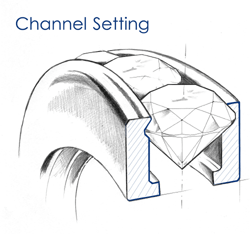pave (pronounced pah-vay) setting is one where the ring’s band is literally paved with diamonds. Small stones encrusted along the ring’s surface give the illusion of a solid diamond surface rather than a metal band. Unlike channel or bezel settings, a pave setting uses only tiny beads or minute prongs to hold each stone, minimizing the appearance of the metal while maximizing the illusion of free-standing diamonds. Most pave settings are constructed from white gold or platinum in order to further minimize the metal, though yellow gold can add a measure of traditional elegance.
As an engagement ring, a pave setting incorporates a larger central stone above the encrusted diamonds, typically in a high tiffany setting. Round and princess are the most frequent shapes for center stones because the remainder of the setting adds sufficient brilliance to the ring without needing a fancier center stone. In some cases, the center stone may be a colored diamond or other gemstone that is heightened by its glittering surroundings. While most center stones are also set with prongs, bezel settings are also popular because they highlight the stone away from the setting.
Pave Design
___________________________________
As an engagement ring, a pave setting incorporates a larger central stone above the encrusted diamonds, typically in a high tiffany setting. Round and princess are the most frequent shapes for center stones because the remainder of the setting adds sufficient brilliance to the ring without needing a fancier center stone. In some cases, the center stone may be a colored diamond or other gemstone that is heightened by its glittering surroundings. While most center stones are also set with prongs, bezel settings are also popular because they highlight the stone away from the setting.
Pave Design
___________________________________
















